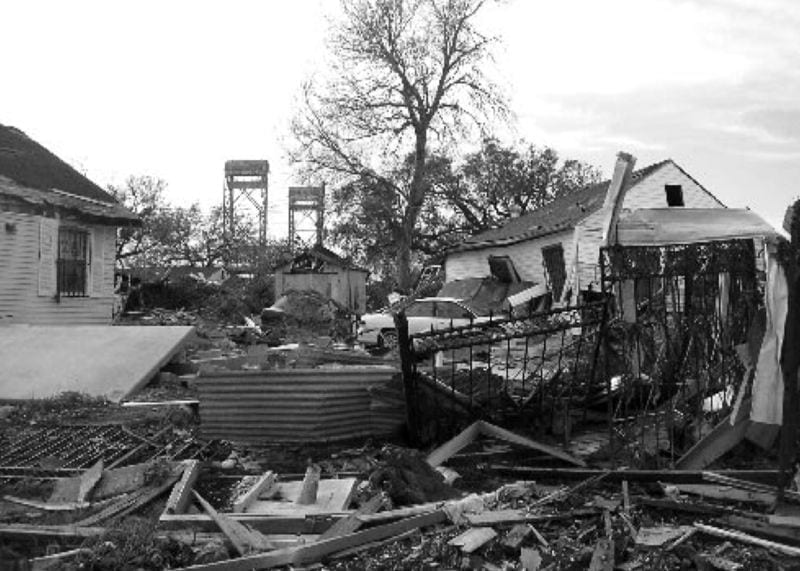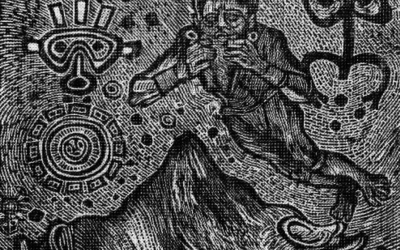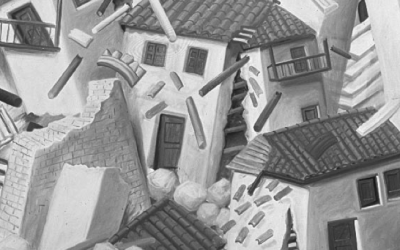Hurricane Katrina and the Re-Latinization of New Orleans
Some Theological Reflections

Hurricane Katrina left a path of destruction that caused an estimated $25 billion dollars in damage. Photo by Elysia Baker.
One of the things that was most immediately obvious to those of us working in relief shelters in the aftermath of Hurricane Katrina was the relative absence of the color brown. Race relations in much of the South and in the city of New Orleans have long been characterized as matters of black and white. One of the most surprising statistics for those around the nation getting a sustained look at the region for perhaps the first time in the aftermath of Katrina was the strikingly low percentage Latinos in the population.
In a course, “Understanding Katrina: Theology, Ethics, and Praxis,” that I taught at Harvard Divinity school this past fall, we reflected on Latino and other experiences of the natural disaster that was Hurricane Katrina. There, we examined the diverse range of issues raised by Katrina: race, class, ethnicity, gender, health, environment, media, faith-based relief efforts, community organizing and numerous other dimensions.
We observed that within the first weeks after the storm, Latino workers flowed in from around the nation in search of employment in the clean-up and reconstruction. This was a startling change from the previous low statistics. Because of previously declining economic opportunities, only 3.1% of the residents of New Orleans before Katrina were Latino, compared to 2.4% statewide and 12.5% nationally. The meager percentage of Latinos in New Orleans had been an aberration in light of sustained migration from Latin America in recent years to places like Georgia, North Carolina, and Virginia and other more prosperous New South locales.
Perhaps there was a special significance in New Orleans’ return to its Latin roots. The Spanish history of the region is pronounced, beginning with the exploration of the area by Spanish explorers in the region in the early 1500’s and culminating in Spanish ownership of Louisiana from 1762 to 1803. The Spanish legacy remains in the architecture of what is now known as the French Quarter, particularly in impressive buildings such as the Cabildo, the seat of the Spanish colonial government located adjacent to Saint Louis Cathedral in Jackson Square.
My students and I examined questions of diaspora and place—certainly topics essential to the Latino experience in this country and in Latin America more generally. In part, these topics seemed to emerge as particularly important because, with the exception of a few students in the class from the New Orleans area, most students were wholly unfamiliar with the region and its “exotic” culture. Of course, the very criteria according to which New Orleans is exotic—warm weather, spicy food, the pronounced incarnational character of the local religion and its rituals like Carnival, or Mardi Gras—are exactly its affinities with Latin culture.
But students were also especially eager to think not only about what makes “place” and culture so central to identity, but also what it meant, particularly theologically, for so many victims of Katrina to have been displaced in what has been described as the largest internal migration in the United States since the “Dust Bowl” days of the Great Depression. The theme of diaspora has been a prominent feature of many world religions, starting in the Judeo-Christian tradition with the exodus of the Jews from Egypt. It is also seen in the syncretism of Afro-Caribbean religions and the synthesis of Roman Catholicism with local traditions in Latin America. In the Katrina class, we inquired into the social and theological meanings of place, including the question of whether attachment to place is anachronistic in our modern, globalized world, so characterized by mobility and migration. We also asked whether diaspora and the portability and mutability of identity are not, in some larger sense, characteristic of our postmodernity and globalization. Latino experience is shaped as much, if not more, than other transnational cultures by these concerns for diaspora and place. The re-Latinization of New Orleans may be yet another case study of that cultural fluidity.
For Latinos, for the most part, it has not been an easy transition. In an front-page article written just two months after the storm, “In Louisiana, Worker Influx Causes Ill Will,” New York Times reporter Leslie Eaton observed, “Much of the overt hostility is focused on the army of Latino workers who appear to be doing much of the dirtiest cleanup work, often in the employ of those big companies, and often for less money that local workers might insist on.” Eaton and other journalists described tent cities under highways, next to cemeteries, and in supermarket parking lots in which Latino workers were living in situations not much better, and in some cases probably worse, than those of the native residents and evacuees whose homes and neighborhoods they were proposing to clean up and cart away as day-laborers for $10 an hour.
In addition to the deficient housing and pay, some Latino workers faced even grimmer scenarios. Reports began to be heard of Latino men being beaten up in the French Quarter by disgruntled mobs and even by officers of the New Orleans Police Department. The story of Juan Molina, a businessman originally from Honduras with a native Louisiana wife and status as a naturalized U.S. citizen for thirteen years drew particular attention. In October 2006, Molina alleges that he was manhandled and subjected to verbal abuse by a police deputy after stopping his truck to talk to a day-laborer whom he thought he knew while on his way out of the Lowe’s hardware store where he had stopped to purchase materials to rebuild his own home. With the help of the Louisiana chapter of the American Civil Liberties Union and the New Orleans Worker Justice Coalition, Molina has initiated an investigation of procedures at the Jefferson Parish police department. The NOWJC has recently released a report titled “And Injustice for All: Worker’s Lives in the Reconstruction of New Orleans” detailing injustices against Latino, African American, Native American, and Asian workers in the rebuilding. (Seewww.neworleansworkerjustice.org).
These stories of exploitation, abuse, and injustice, as tragic and unfortunate as they are, testify to a very common effect of natural disasters—the potential for dramatic demographic, social and cultural change. The influx of Latino workers to New Orleans and the Gulf Coast is the flip-side of the diaspora and dispersal of predominantly African American evacuees to points around the nation. Far from being a matter of chocolate or vanilla, as New Orleans Mayor Ray Nagin, so memorably, if controversially, put it in asserting that post-Katrina New Orleans would remain “chocolate city,” some argue that we may be seeing the re-Latinization of New Orleans in a manner consistent with its Spanish past.
The new flavor of New Orleans may well be, as columnist Ruben Navarrette, Jr. put it, the golden brown, caramel color ofdulce de leche. In an article titled, “There’s More than One Color in the Rainbow,” Navarrette describes New Orleans as a potential “ground-zero in the tug of war between African Americans and Hispanics” over economic opportunities. Writing in April 2006, he reports a 20% increase in Latino population in New Orleans, with projections of 30% in the near future. Navarrette ultimately debunks the specter of African American-Latino antagonism, pointing to the possibility of peaceful coexistence through a further gastronomic remark on the similarities between jambalaya and paella.
In another report on Latino life after Katrina, “¡Vaya Tormenta! In the Shadows of Katrina,” writer Christopher Miles argues from his perspective on the Mississippi Gulf Coast, “In the shadows of Katrina, Latinos have become part of our cultural landscape. Yet they have always been here.” Miles is speaking here of the Spanish history of the area, as well as the more recent settlement of Latinos, particularly across the South in a remarkably dispersed fashion to cities and towns of various sizes. Of the increase in Latino population in Mississippi from 1.4 to 1.5 percent in recent years Miles observes, “The state’s population is found primarily in small towns and rural areas. There outsiders are much more noticeable.” This paradox of shadowy invisibility in some respects and extreme vulnerability in others is a continuing challenge for Latinos along the Gulf Coast. The visibility and vulnerability from having a skin color that is neither black nor white has been cited as a factor in some of the violence and abuse that has been perpetrated against Latino workers.
Concerns about injustice led to another issue that captured the interest of my class. In an editorial on the aftermath of Katrina, political theorist Michael Ignatieff wrote about “The Broken Contract.” Much class discussion on the state of social contract, before and after Katrina, hinged on matters of race, particularly black and white. Yet Native Americans, Asian Americans, and Latinos equally demand a seat at the contract drafting table, especially in times of demographic change. What do changing demographics require in the way of redrafting the social contract? These are questions with which New Orleans and the Gulf Coast will be dealing in the years ahead.
At the theological level, our discussions initially centered on classic theological concerns of theodicy, prophecy and lamentation. How is it that natural disasters raise questions of the goodness and justice of the divine cross-culturally and across religious traditions, as suggested in religious responses to the Asian Tsunami of 2004? If we discern that human agency (environmental degradation, poor levee construction) is at fault instead of or alongside other factors, what prophetic and political call for accountability and justice is required of us? How do we find the capacity to lament and mourn our losses from natural disaster in a fast-pace modern world that urges us to seek “closure” and move on?
Toward the end of the course, our theological reflections moved more in the direction of a particular political science term that has been invoked to explain everything from suburbanization of American residential patterns to the Red State-Blue State divide in American politics. It was named one of the most important ideas of 2006 in a New York Times year-end retrospective. It is also implicated in the singling out of Latino workers for abuse. This is the idea of homophily—what some identify as human tendency to seek out and surround ourselves with people like ourselves and to resist those who are different. As we considered the idea of homophily in the Katrina class, we wanted very much to supplant it with a theme of hospitality. Hospitality is very much a theme of the Christian Gospel message, illustrated in the many instances of hospitable receptions of Jesus in the New Testament and even toward strangers, as in the story of the Good Samaritan. It has even older roots in the Hebrew Bible in the command to take care of widows, orphans, and especially the “aliens” or vulnerable strangers among us.
The theme of hospitality with its connection to mobility and journeys and its demand that we receive and welcome the stranger seems especially resonant after Katrina—in the reception of evacuees, in the diaspora that is likely to be permanent for many, and in the call to welcome displaced residents back home, particularly those who may have a sense of never having been welcome in the first place or who now feel unwelcome as a result of the government’s slow political response to the disaster. It is a crucial theme in the treatment of the new Latino population, who are contributing greatly to the rebuilding but working in conditions that are frequently unjust. The theme of hospitality seems applicable, indeed, so broadly in our world, which increasingly finds itself globally connected in ways that promise harmony and unity, but which also heighten perceptions of difference and relationships of conflict. Hospitality may be equally broadly applicable as a theological concept in circumstances of natural disaster, which, while they tend to affect some people, particularly the poor, disproportionately, also call us to solidarity and relationship.
Winter 2007, Volume VI, Number 2
M. Christian Green is Visiting Lecturer on Ethics at Harvard Divinity School. She is a native of New Orleans. In March 2006 she accompanied HDS faculty, staff, and students on a Katrina relief trip to the Gulf Coast, and she will do so again during Spring Break 2007.
Related Articles
Editor’s Letter: Natural Disasters
We were little black cats with white whiskers and long tails. One musical number from my one and only dance performance—in the fifth grade—has always stuck in my head. It was called “Hernando’s Hideaway,” a rhythm I was told was a tango from a faraway place called Argentina.
After the Earthquake: Juan’s Life
Juan was a construction helper. He lived in Armenia, but his parents were from the Antioquia region, who had fled because of the violence there. The mother of his children was called…
Political Memory
Late in 1717 Dr. Joseph Surin, precentor of the Cathedral of Old Guatemala, carried out some calculations: had the mudslide that wiped the city on the 28th of August, feast day of Saint…




